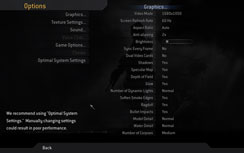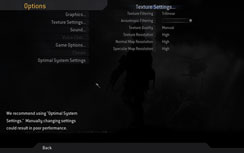G94: Nvidia GeForce 9600 GT 512MB
Written by Tim Smalley
February 21, 2008 | 15:48
Tags: #9600 #amp #architecture #card #consumption #details #edition #evaluation #g94 #geforce #gt #performance #power #review #usage

Call of Duty 4: Modern Warfare
Publisher: ActivisionCall of Duty 4: Modern Warfare is different to all previous Call of Duty games, as it moves the action out of the World War II era and into the modern day. We have used the full version of the game with the 1.4 patch applied.
The game runs on a proprietary engine, which includes features like true world dynamic lighting, HDR lighting, dynamic shadowing and depth of field. Unlike most triple-A games that were launched late in 2007, Call of Duty 4: Modern Warfare only uses a DirectX 9.0 renderer and, given the realistic nature of the graphics, it proves that there's still life left in the old dog!
For our gameplay testing, we did a 90 second manual run through in the second mission of the game. All of the in-game settings were set to their maximum values, including texture details which were configured to 'Extra'. The 'Dual Video Cards' option was enabled for the Radeon HD 3870 X2 and Radeon HD 3870 CrossFire configurations, but was disabled in all single GPU configurations.
Finally, anti-aliasing and anisotropic filtering were controlled from inside the game.
Call of Duty 4: Modern Warfare
1280x1024 0xAA 16xAF, High Quality, Medium Corpses, High Textures
- Nvidia GeForce 8800 GT 512MB
- Zotac GeForce 9600 GT 512MB AMP! Edition
- Nvidia GeForce 8800 GS 384MB
- ATI Radeon HD 3870 512MB
- Nvidia GeForce 9600 GT 512MB
- PowerColor Radeon HD 3850 Xtreme PCS 512MB
- ATI Radeon HD 3850 256MB
- ATI Radeon X1950 Pro 256MB
- Nvidia GeForce 8600 GTS 256MB
-
-
79.9
-
49.0
-
-
-
71.3
-
41.0
-
-
-
66.4
-
40.0
-
-
-
66.2
-
39.0
-
-
-
63.4
-
38.0
-
-
-
62.2
-
38.0
-
-
-
57.5
-
35.0
-
-
-
35.8
-
22.0
-
-
-
35.2
-
20.0
-
0
10
20
30
40
50
60
70
80
Frames Per Second
-
Average
-
Minimum
Call of Duty 4: Modern Warfare
1280x1024 2xAA 16xAF, High Quality, Medium Corpses, High Textures
- Nvidia GeForce 8800 GT 512MB
- Zotac GeForce 9600 GT 512MB AMP! Edition
- Nvidia GeForce 9600 GT 512MB
- Nvidia GeForce 8800 GS 384MB
- ATI Radeon HD 3870 512MB
- PowerColor Radeon HD 3850 Xtreme PCS 512MB
- ATI Radeon HD 3850 256MB
- ATI Radeon X1950 Pro 256MB
- Nvidia GeForce 8600 GTS 256MB
-
-
63.5
-
42.0
-
-
-
58.1
-
38.0
-
-
-
51.5
-
33.0
-
-
-
50.3
-
32.0
-
-
-
44.4
-
30.0
-
-
-
40.9
-
28.0
-
-
-
37.6
-
25.0
-
-
-
28.7
-
18.0
-
-
-
27.8
-
18.0
-
0
10
20
30
40
50
60
70
Frames Per Second
-
Average
-
Minimum
Call of Duty 4: Modern Warfare
1680x1050 0xAA 16xAF, High Quality, Medium Corpses, High Textures
- Nvidia GeForce 8800 GT 512MB
- Zotac GeForce 9600 GT 512MB AMP! Edition
- Nvidia GeForce 8800 GS 384MB
- ATI Radeon HD 3870 512MB
- PowerColor Radeon HD 3850 Xtreme PCS 512MB
- Nvidia GeForce 9600 GT 512MB
- ATI Radeon HD 3850 256MB
- ATI Radeon X1950 Pro 256MB
- Nvidia GeForce 8600 GTS 256MB
-
-
68.8
-
41.0
-
-
-
58.1
-
38.0
-
-
-
56.1
-
34.0
-
-
-
55.5
-
35.0
-
-
-
53.2
-
33.0
-
-
-
53.0
-
32.0
-
-
-
50.2
-
30.0
-
-
-
30.8
-
19.0
-
-
-
28.6
-
17.0
-
0
10
20
30
40
50
60
70
Frames Per Second
-
Average
-
Minimum
Call of Duty 4: Modern Warfare
1680x1050 2xAA 16xAF, High Quality, Medium Corpses, High Textures
- Nvidia GeForce 8800 GT 512MB
- Zotac GeForce 9600 GT 512MB AMP! Edition
- Nvidia GeForce 9600 GT 512MB
- Nvidia GeForce 8800 GS 384MB
- ATI Radeon HD 3870 512MB
- PowerColor Radeon HD 3850 Xtreme PCS 512MB
- ATI Radeon HD 3850 256MB
- ATI Radeon X1950 Pro 256MB
- Nvidia GeForce 8600 GTS 256MB
-
-
52.5
-
34.0
-
-
-
47.6
-
32.0
-
-
-
42.7
-
28.0
-
-
-
42.4
-
28.0
-
-
-
36.2
-
25.0
-
-
-
33.3
-
22.0
-
-
-
31.1
-
21.0
-
-
-
23.6
-
15.0
-
-
-
22.9
-
14.0
-
0
10
20
30
40
50
Frames Per Second
-
Average
-
Minimum
What we see in Call of Duty 4 is an opportunity lost for AMD, because if it wasn't for the poor anti-aliasing performance, there would be a lot more to think about. Sadly, the Radeon HD 3000-series' lacklustre performance when anti-aliasing is enabled means there's really no contest here because, although the reference GeForce 9600 GT is slightly slower than both the PowerColor Radeon HD 3850 and the reference HD 3870 when anti-aliasing is disabled, it's significantly faster when it's enabled.
Interestingly, if you're not bothered about anti-aliasing, an unlikely suspect tips up – the card that Nvidia is essentially replacing with the GeForce 9600 GT. That is, of course, the GeForce 8800 GS and it seems that the 192-bit memory bus isn't causing a problem when anti-aliasing is disabled. When it's enabled, it doesn't suffer too badly either, being about the same speed as the reference 9600 GT.
Finally, Zotac's card again performs well, and it again comes close to the GeForce 8800 GT's performance.











Want to comment? Please log in.